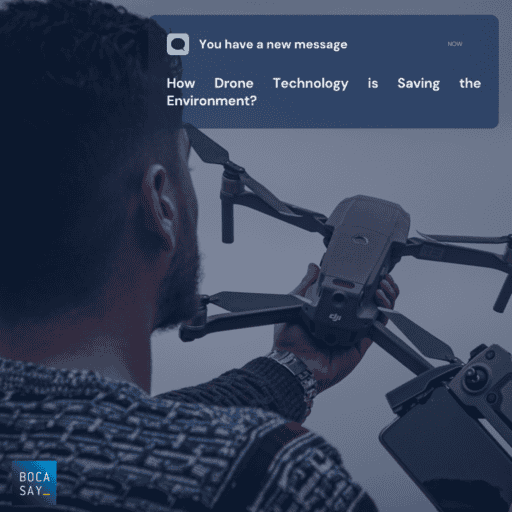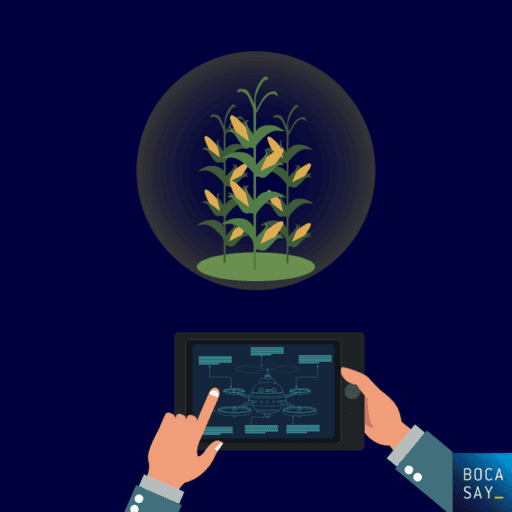How Drone Technology is Saving the Environment?
Providing a unique bird’s eye view for the operator, drones are particularly well suited for providing key assistance with both humanitarian and environmental challenges and disasters. Able to cover large amounts of land quickly and cost-effectively, drones are not just amazing for easily reaching remote areas, they are also playing a key role in preserving our environment.
In this article, we’ll go over the basics and continue with 5 ways drones are helping us build a more sustainable future for our natural environment.

What is Drone Technology?
Navigated using the Global Positioning System (GPS), drones are basically unmanned aircraft that can fly with varying degrees of autonomy, relying on software-controlled flight paths. Being remotely operated, drones can fly autonomously for a wide range of applications including mapping, search and rescue operations, nature and agricultural monitoring, as well as product deliveries in difficult-to-reach areas. It’s also important to consider that there are also underwater drones (also known as autonomous underwater vehicles – AUVs) that help scientists to monitor critical conditions of our oceans and ecosystems.
Main Types of Drones
Drone types are generally divided into the following categories:
Multi Rotor Drones: The most common type of drone used by both professionals and amateurs. Common uses include aerial photography and video surveillance. While relatively cheap, disadvantages can include limited flying time, endurance and speed.
Fixed Wing Drones: This type of drone aircraft uses a wing system similar to conventional airplanes. Unlike multi rotor drones, fixed wing drones have an average flying time of a couple of hours, making them ideal for long-distance operations.
Single Rotor Drones: A single rotor drone is the closest thing to an actual helicopter. Providing high-stability and efficiency, this type of drone is characterized by its ability to fly for a long time, as well as for its higher complexity and operational safety risks.
Fixed Wing Hybrid VTOL: Hybrid versions of drone aircraft, combining the benefits of fixed wing drones – that is longer flying times – with the amazing stable hovering ability of rotor-based drones. Operation is available in both manual and auto-pilot modes.
Autonomous Underwater Vehicles: AUVs are used in underwater survey missions. For example, they can detect shipwrecks, rocks and obstructions for ships. An AUV can conduct various underwater surveys without the need for human operator intervention.
𝔸𝕣𝕖 𝕪𝕠𝕦 𝕝𝕠𝕠𝕜𝕚𝕟𝕘 𝕗𝕠𝕣 𝕒𝕟 𝕀𝕋 𝕡𝕒𝕣𝕥𝕟𝕖𝕣 𝕥𝕠 𝕠𝕡𝕥𝕚𝕞𝕚𝕫𝕖 𝕪𝕠𝕦𝕣 𝕡𝕖𝕣𝕗𝕠𝕣𝕞𝕒𝕟𝕔𝕖 𝕥𝕠𝕠𝕝𝕤? 𝔹𝕠𝕔𝕒𝕤𝕒𝕪’𝕤 𝕀𝕋 𝕕𝕖𝕧𝕖𝕝𝕠𝕡𝕖𝕣𝕤 𝕒𝕣𝕖 𝕖𝕩𝕡𝕖𝕣𝕥𝕤 𝕚𝕟 𝕔𝕦𝕤𝕥𝕠𝕞 𝕤𝕠𝕗𝕥𝕨𝕒𝕣𝕖 𝕕𝕖𝕧𝕖𝕝𝕠𝕡𝕞𝕖𝕟𝕥. 𝕎𝕙𝕒𝕥𝕖𝕧𝕖𝕣 𝕪𝕠𝕦𝕣 𝕟𝕖𝕖𝕕, 𝔹𝕠𝕔𝕒𝕤𝕒𝕪 𝕙𝕒𝕤 𝕥𝕙𝕖 𝕤𝕠𝕝𝕦𝕥𝕚𝕠𝕟. 𝕐𝕠𝕦 𝕕𝕠𝕦𝕓𝕥 𝕚𝕥? ℂ𝕠𝕟𝕥𝕒𝕔𝕥 𝕠𝕦𝕣 𝕥𝕖𝕒𝕞 𝕟𝕠𝕨!
The Environmental Benefits of Drones
Aerial Mapping ✈️
Drones provide enormous assistance for complex aerial mapping procedures. A drone can provide 3D models and maps for a large construction project, establishing an efficient project monitoring method that reduces manual work hours and energy consumption.
By providing images with extremely high resolutions, drones can carry out topographic surveys that are as accurate as traditional methods but only require a fraction of the time. Significantly optimizing land management, by reducing the cost of a site survey and the workload of field specialists, drones can even provide better quality images than satellites since they can fly at a low height of up to 200m in order to avoid clouds.
Environment Monitoring 🔎
Unmanned aircraft have revolutionized the way we monitor and preserve our natural environment. Apart from high quality cameras, drones can also carry a wide range of meteorological equipment such as wind gauges, thermometers, as well as humidity and pressure sensors.
Addressing complex environmental conservation challenges, drone technology currently enables us to monitor marine life and water quality in protected oceans, to track forest health and reseed deforested areas, as well as to accurately map the climatic conditions of often-inaccessible tropical rainforests and wetlands.
Whether it’s the mapping of lava flows in Hawaii, or the water reserves around the capital of Chad, the significance and benefits of drones for scientists and environmental researchers will only continue to grow in the future.

Sustainable Agriculture 🌾
In both farms and generally agricultural land, drones are increasingly replacing more power-hungry machinery in order to perform a wide range of tasks. Becoming precision agriculture instruments, drones can help with optimizing fertilizer use (basically reducing it and minimizing soil pollution), as well as with monitoring livestock, crop health and water levels.
High-resolution images enable farmers to instantly identify areas with problematic vegetation and to direct farmworkers to crops in need of attention. Ultimately, drones provide farmers with the ‘big picture’ regarding all aspects of their operation, minimizing the environmental impact of agricultural activity, as well as improving yields and overall efficiency.
Disaster relief 🌋
Fast, cheap and able to reach inaccessible areas, drones are increasingly used to assess, prevent and even combat environmental disasters. Disaster management benefits from drones being able to cover large areas and collect critical data that optimize how resources are allocated, ultimately minimizing the damage and saving lives.
For example, drones can deliver small packages of critical aid to remote areas during a major flood, or help firefighters monitor and prevent the spread of a wildfire. In addition, drones can monitor land areas that are vulnerable to landslides, constantly detecting manute cracks in the soil, and automatically alerting the relevant authorities to take action.
Wildlife Protection 🦊
A drone is an amazing tool for safely tracking populations of wild animals, as well as for spotting poachers early enough to stop them. Equipped with cameras, laser lights, GPS tracking, altimeters and other features, cutting-edge conservation drones can also use thermal and long-distance focal-point cameras to monitor wildlife during both daytime and nighttime.
Amazon tribes are using drones to track illegal loggers and poachers in the Brazilian rainforest. Increasing environmental security in difficult-to-reach areas, drones can help us protect endangered species from illegal human activities. There are even drone aircraft capable of detecting ailing trees.